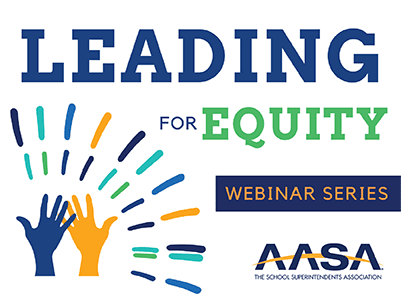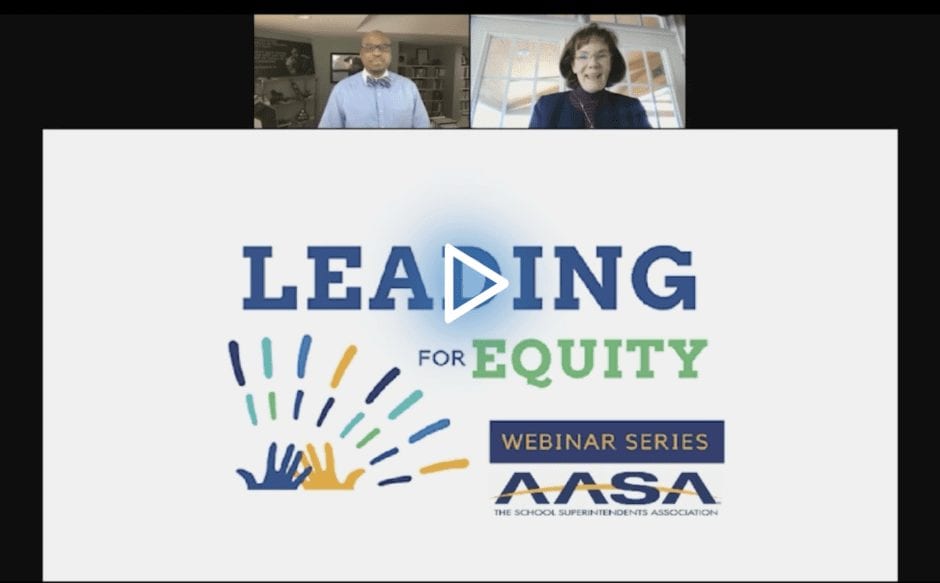Understanding Implicit Bias and Overcoming It in Our Schools
By Robert Low
If implicit bias is unconscious and something that everyone experiences, how can educators prevent, or at least minimize, its impact on students?
During a recent edWebinar, hosted by AASA, The School Superintendents Association and AASA’s Leadership Network, Dr. Bryant T. Marks, Sr., Executive Director of the National Training Institute on Race and Equity at Morehouse College, explained how increasing awareness and then taking effective, data-driven action can result in more equitable treatment of diverse students.
Dr. Marks also clarified while implicit bias is currently a hot topic, it has been identified and studied by social scientists for more than half a century, so there are research studies and historical data that document how it works and why it is so pervasive.
Defining Implicit Bias and Its Impact
Implicit bias is the “differential treatment of another human being based on the group” the person is perceived to be part of. Dr. Marks explained the human brain automatically and unconsciously associates certain traits with groups of people over time, and after hundreds or thousands of such associations, our brains make certain assumptions about people without our being consciously aware of that process.
In the United States, implicit biases are often based on perceived gender and age, as well as skin color or race. One example cited by Dr. Marks is that the word “nurse” is usually associated with a woman, while a surgeon is assumed to be a man, simply because that is what most of us have seen repeatedly when we were growing up. After this sort of repeated exposure, our brains recognize the pattern and begin to link the job title and gender automatically.
Dr. Marks emphasized this is not a matter of character and is simply the result of having a brain and being exposed to our society because our minds are “cognitive machines that automatically attempt to categorize and encode” our experiences in order to be more efficient.
The problem for educators and their students is the impact of implicit biases depends to a large extent on the roles people have in our society, so in professions such as education, as well as criminal justice and medicine, the impact can be profound and lifelong. Practitioners in these fields therefore have a responsibility to determine what biases they have and whether they are systematically advantaging or disadvantaging any particular group.
Dr. Marks pointed out an elementary teacher working with 25 students a year during a 35-year career will have had a deep and lasting impact on more than 800 young people during their formative years, so the effects of just one teacher’s implicit bias can be widespread and long-lasting. The good news is implicit biases can be “overridden at the conscious level,” resulting in the links between implicit biases and job performance being cut.
Building Awareness and Taking Action
Dr. Marks recommends a three-step plan for working on implicit bias, based on assessment, awareness and action. The first step is to identify the type, extent, and impact of implicit biases, which can be done through assessments such as implicit association tests, but also through surveys and other types of feedback collection. This can include explicit conversations with colleagues, which can be difficult but eye opening.
The data collected during the assessment phase can then be presented and discussed with a district or school’s leadership, staff, and other stakeholders, in order to build awareness, review recommendations fairly, and agree on action plans. These may also be tough conversations, and can be helped by empathy, openness, and non-judgmental attitudes, and based on the shared recognition implicit biases are a matter of unconscious brain function rather than personal character.
Action plans resulting from these conversations should be focused on bias-reducing policies and practices, and include transparency, standards, and accountability that results in consequences if necessary. The fact that everyone has implicit biases cannot be a free pass for harmful behavior that continues to have a negative impact on individuals or groups of people.
The action plans for bias reduction also need to take into account the extent of the plan’s impact, starting with individual action and organizations such as schools or districts. There also needs to be consideration of larger systems, such as the teacher unions, school boards, and other groups involved in setting and implementing a district’s policies, as well as larger ecosystems such as city, county, or state governments that can have a powerful and widespread impact as well.
Dr. Marks pointed out the long-term demographic trends taking place in America are already reaching a tipping point in our nation’s schools, where the percentages of White, Black, Hispanic, and Asian students are changing significantly. Educators therefore have a responsibility to respond effectively to these changes and treat their diverse student populations equitably, and by doing so they will be shaping the next generation of citizens in a positive way, while also setting the right example for other professions.
This edWeb broadcast was hosted by AASA, The School Superintendents Association and AASA’s Leadership Network, providing premier professional learning for educational leaders.
About the Presenter
Dr. Bryant T. Marks, Sr. is a minister, researcher, trainer, and award-winning educator. Dr. Marks has provided diversity, equity, and inclusion training for eighteen years. His personal and professional mission is to develop the knowledge, wisdom, and skills of others that will allow them to reach their full potential and live their lives with purpose and passion. Dr. Marks is the Founding Director of the National Training Institute on Race and Equity and is a professor in the Department of Psychology at Morehouse College. He served on President Obama’s Board of Advisors with the White House Initiative on Educational Excellence for African Americans and as a senior advisor with the White House Initiative on Historically Black Colleges and Universities.
Dr. Marks was a contributor/trainer with the Obama Administration’s My Brother’s Keeper (MBK) and 21st Century Policing programs. Dr. Marks has provided implicit bias training to over 2,000 Police Chiefs and executives via a series of briefings at the White House in 2016, and several thousand patrol officers in local police departments including the entire Los Angeles Police Department. He has also provided training related to diversity and implicit bias to individuals in education (K-12 and higher education), philanthropy, non-profits, local and federal government, and several other sectors. He serves on several national boards and is a highly sought-after speaker and trainer.
Dr. Marks holds a B.A. in psychology and a minor in economics from Morehouse College, and an M.A. and Ph.D. in social psychology from the University of Michigan. Dr. Marks conducts research and professional development in the areas of diversity and implicit bias, Black male psychology and development, the academic achievement of minority college students, innovations in STEM education, and personal passion and productivity.
About the Host
Dr. Valerie Truesdale joined AASA early in 2019 as the assistant executive director responsible for guiding leadership development services and programs. With years of experience in the superintendency and roles in instructional technology, she knows that AASA’s Leadership Network can be a substantial resource for school leaders trying to keep pace with the rapidly changing delivery of K-12 education.
Join the Community
Leading for Equity is a free professional learning community on edWeb.net for school and district leaders who face many challenges leading schools and driving school improvement for all students, especially now with COVID-19.
The AASA Leadership Network drives superintendent success, innovation and growth, shaping the future of public education while preparing students for what’s next. We are the largest, most diverse network of superintendents in America. Passionate and committed, we connect educational leaders to the professional learning, leadership development, relationships and partnerships they need to ensure a long career of impact.
Robert Low has more than 30 years of educational publishing experience, ranging from editing and product management to online advertising and content development. He also works with edWeb.net to write articles on their professional learning edWebinars.






Comments are closed.